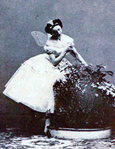主题:舞蹈
| 此主題目前正依照其他维基百科上的内容进行翻译。 (2017年4月6日) |
舞蹈主題
舞蹈是八大艺术之一,是於三度空間中以身體為語言作「心智交流」現象之人体的运动表达艺术,一般有音乐伴奏,以有节奏的动作为主要表现手段的艺术形式。它一般借助音乐,也借助其他的道具。舞蹈本身有多元的社會意義及作用,包括運動、社交/求偶、祭祀、禮儀等。
特色條目
Acrobatic dance emerged in the United States and Canada in the early 1900s as one of the types of acts performed in vaudeville. Although individual dance and acrobatic acts had been performed in vaudeville for several decades prior to 1900, it was not until the early 1900s that it became popular to perform acts that combined dance and acrobatic movements. Since the decline of the vaudeville era, acrobatic dance has undergone a multi-faceted evolution to arrive at its present-day form. The most significant aspect of this evolution is the integration of ballet technique as the foundation for dance movements, thus bringing into acro dance a precision of form and movement that was absent in vaudeville acrobatic dance.
特色圖片

The can-can (also spelled cancan, Can Can) is regarded today primarily as a music hall dance, performed by a chorus line of female dancers who wear costumes with long skirts, petticoats, and black stockings, harking back to the fashions of the 1890s. The main features of the dance are the lifting up and manipulation of the skirts, with high kicking and suggestive, provocative body movements.
特色傳記
Emma studied dancing while young and attended the Paris Opera School. She made her debut at age sixteen with the Paris Opera as the sylph in La Sylphide. Her talent brought her fame and she became a widely respected ballerina.
Marie Taglioni noticed her during one of her performances and immediately took a liking to the girl, becoming her mentor. Marie choreographed for Emma in the ballet Le Papillon, a piece by Jacques Offenbach that was especially created just for Emma.
歡迎參與
分類
In arts • Awards • 芭蕾 • Ballroom • 啦啦隊 • Competitive • Contemporary • Culture • Dancers • Dances • Education • By ethnicity or region • Folk • Health • Historical • Hip Hop • Lists • Magazines • Music • Musical theatre • Notation • Occupations • Organizations • Props • Syllabus-free • Technique • Television shows • Venues • Video games • Websites Writers •




